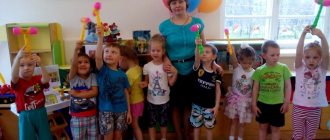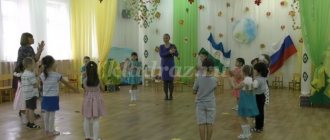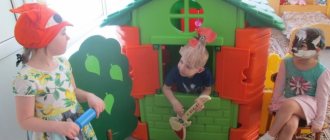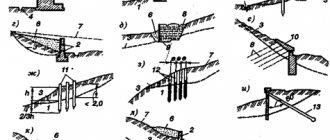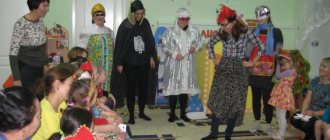Card index of musical games preparatory group
Compiled by teacher Lapshina E.A..
"Broken TV"
Tasks:
Development of inner hearing, skills of accurate and fluent intonation. Development of rhythmic organization and attention.
Game description:
Children sing a familiar song. At a sign from the music director, they fall silent, continuing to sing to themselves, trying not to lose the thread of the melody (the TV broke: the image remained, the sound disappeared). At the moment the sound is turned on (also at the signal of the music director), it is important not to lose the intonation and semantic line. The inclusion must be precise.
"Pass this song around"
Tasks:
Development of the desire for physical and psychological liberation, freedom of movement. Formation of rhythmic organization.
Game description:
Children stand in a circle and are divided into two equal groups. One group accompanies the song by clapping their palms, as directed by the teacher, meter, rhythm, and various durations. The second group copies the movements of the leader, who is in the center of the circle. The children sing the song non-stop. At the last phrase, the presenter changes places with the child he has chosen from the circle. Game continues. At a sign from the music director, the groups change roles.
"Guessing Game"
Tasks:
Formation of a constant desire for correct intonation. Activation of auditory perception.
Game description:
One child stands with his back to the group of children, one of them performs a chant. The task of the child, standing with his back, is to guess the timbre of the soloist’s voice.
"Listen, compose and watch"
Tasks:
Forming a desire for a deeper and more meaningful penetration into musical material. Development of the ability to record its various stages.
Game description:
Children are invited to listen to music from any animated film (without video) and imagine a story that reflects what they heard. Children take turns sharing their stories. The game ends with watching the cartoon and analyzing figurative coincidences.
"Musical Theatre"
Tasks:
Activating children's interest in various types of instruments. Formation of rhythmic thinking. Development of fantasy. Memory training.
Material:
Tambourine, bells, xylophone, metallophone, triangle), and fairy tale plots.
Game description:
Children must tell a story using musical instruments. Each participant in the game presents his own instrument. The teacher offers a fairy tale plot, and the children select an instrument that matches the sound of each character in the fairy tale, and then the desired rhythmic pattern. For example. Karabas-Barabas is a tambourine, Pinocchio is a xylophone, Malvina is a bell, Pierrot is a triangle, Artemon is a rattle.
The text of the fairy tale is voiced.
"When objects begin to sound"
Tasks:
Development of imagination, creativity (the world around us becomes more voluminous and multifaceted)
Material:
Selection of items necessary for the game (sheet of paper, pencil, ruler, etc.). poetic texts.
Game description:
At the beginning of the game, different objects are used alternately to achieve the maximum number of sound associations. For example: a slight vibration of a sheet of paper is associated with the sound of the wind; squeezing a sheet of paper in your hands - with steps in the snow; the sound of slowly tearing paper - with the creaking of wood; sharp strokes of a pencil on a sheet of paper resemble the crackling of burning logs; light tapping - raindrops; blows on the edge of the paper - the knock of a woodpecker, etc. Similarly, you can use each subject, connecting all sorts of fantasies of the teacher and children.
After reaching the maximum number of options, the transition begins to the next stage - sound combinations. Next, the teacher sets tasks for depicting specific paintings. Nature: forest, sea, rain. Natural elements: storm, storm, rain, blizzard. Conveying feelings: anger, joy, peace, tenderness. At the next stage, the games become more complex to a certain plot. For example, voicing a poem.
"Singing Hands"
Tasks:
Develop plastic hand movements and creative imagination.
Game description:
After listening to the music, the teacher asks the children to imagine. That they are residents of a fairy-tale country where people don’t know how to talk. You can communicate only using the language of movements and facial expressions. The teacher discusses with them the options for figurative movements: wavy, circular, shaking, finger tapping, etc. The transmission of tempo and dynamics is achieved by different amplitudes, speeds, and strength of movement.
"Good Old Pelican"
Tasks:
Introduction to concepts: accompaniment, registers, downbeat. Forte (loud), piano (quiet).
Game description:
Children must voice the accompaniment of the melody with the voices of a tambourine, a bird, a mouse, a dog, and a clock.
- put a sheet of paper on one knee and hit the downbeat with your palm (large pelican), and with your finger - small pelican.
- holding a sheet of paper in front of you, hitting it with your palm - a tambourine, clicking with your finger - a bird.
- shake a sheet of paper in front of you - mouse.
- roll a piece of paper into a tube, hit it on the table with quarters - a clock.
- tearing a sheet of paper on the downbeat - dog.
"Money box"
Tasks:
Reinforce words that characterize the mood of a piece of music and the musical image. To promote the adequate application of knowledge about music in the analysis of a musical work. Reveal preferences, encourage the expression of motivated assessment.
Game description:
After listening to a piece of music, the teacher asks the children to cup their hands, then turns to the children:
“What a spacious piggy bank you each have!” What will we put in it? Children offer various options. The teacher continues: “Let’s collect beautiful words that will correctly tell about the music we listened to. Draws attention to the fact that you need to be careful. If the word suits us, we close it in the piggy bank. If it does not match the mood of the music, the palms are spread apart.
"Magic chest"
Tasks:
Reinforce words that characterize the mood of a piece of music and the musical image. To promote the adequate application of knowledge about music in the analysis of a musical work.
Material:
Colored chips.
Game description:
A magic chest, covered with a bright silk scarf, stands on the table. The teacher draws attention to the sound of mechanical music and suggests finding the place from where it can be heard. Children find a magic chest. The teacher invites the children to listen to different pieces of music and put words in a magic chest that can be used to tell about her mood. For each correct answer, the child receives a chip. If the “wrong word” is spoken, the chest slams shut.
"Singing Competition"
Tasks:
Develop emotional responsiveness to music. To promote awareness of the expressiveness of the musical image, the auditory differentiation of the musical fabric of the work. Promote the expression of values.
Game description:
The teacher announces that a singing competition is taking place. He explains that at a vocal competition, singers perform a mandatory program, i.e. identical works, and the jury evaluates their skill. Names the piece that all participants in the competition must perform. A jury is selected - a teacher and two children. After this, those who wish to participate take part. The winner is the one who sings the melody expressively.
"Come up with a song"
Tasks:
Listen to the music carefully. Compose your own melody of a similar mood.
Game description:
After listening to the music, the teacher says that during the music lessons there was a lot of different music dedicated to summer, and each had its own unique mood. Different composers have written different music about summer. Which one would you write? Let's say the magic words that will help us do this. They call them. For example, cheerful, bright, etc.
"Sculptors"
Tasks:
Conveying an image using pantomime.
Game description:
In the game, children comprehend a stylized idea and convey it in static body plasticity. After listening to the music, the teacher introduces the children to the game. Children act in pairs. One child plays the role of a sculptor, the other - clay. A child sculptor shapes the clay according to his own impressions of the music he listened to. A clay child must be obedient, soft, and pliable. When the work is completed, the sculptor tells everyone about his artistic concept and the means by which it was conveyed.
"Butterfly Outfit"
Tasks:
To promote awareness of an expressive musical image, the texture of musical fabric based on the associative connection of tactile and auditory impressions. Develop figurative vocabulary and imagination.
Game description:
After listening to Schumann’s music “Butterflies” (No. 1-5), the teacher says that today the butterflies have gathered for the carnival. Each butterfly spent a long time choosing a dress for itself, because it should not only be beautiful, but also fit well. It must match the mood and character of each butterfly. Butterflies twirled in front of the mirror, but could not choose a dress for themselves. The teacher shows a tablet with butterflies made from different fabrics: silk, organza, velvet..., asks to look at each outfit and choose a ball gown for each musical butterfly. At the end there is a butterfly dance.
"Musical Umbrella"
Tasks:
Teach children to feel and reproduce the rhythmic pulse of speech (poems) and music. To develop auditory attention, a sense of rhythm, and basic music-playing skills in an orchestra. Cultivate an interest in playing musical instruments.
Material:
Musical instruments. An umbrella with images of these instruments glued to its edges.
Game description:
Children stand in a circle. The teacher rotates the umbrella to the accompaniment of cheerful rhythmic music. Accompanying your actions with the words:
“We rotate the umbrella slowly.
Close the eyes with a pen.
The umbrella will choose
What should you play now?
At the end of the music, the children open their eyes, and each child takes the instrument whose image he sees in front of him. Then everyone plays orchestra together.
"Musical Lotto"
Tasks:
Development of pitch hearing.
Material:
Cards according to the number of players. On each are drawn 5 lines (staff), circles-notes, and children's musical instruments.
Game description:
The child leader plays the melody on one of the instruments up, down or on one sound. Children should put notes in circles from 1 to 5 on a card or on one line. The game is played during free time from classes.
"Steps."
Tasks:
Development of pitch hearing.
Material:
A ladder of 5-7 steps, toys, children's musical instruments.
Game description:
The leading child plays a melody on any instrument, and the other child determines the movement of the melody up, down, or on one sound. A child uses a toy to show how to move up the steps.
"Rhythm cubes"
Tasks:
Develop children's understanding of rhythm.
Material:
Wooden blocks short and long.
Game description:
The teacher performs the song, paying attention to the character and clear rhythm. When performing again, it is suggested to clap the rhythm with your hands, and then lay out the rhythmic pattern of the chant with small blocks. Short bars short sounds. Long bars - long sounds. Musical material: “Magpie”, “Andrew Sparrow”, etc.
"Fun Train"
Tasks:
Strengthen the ability to distinguish changes in the tempo of music.
Material:
Toy train, wooden cubes.
Game description:
The teacher performs a play in which the image of a moving train is conveyed; at first slowly, then faster, quickly, towards the end the movement slows down. When performing again, 1 child is asked to move the toy train to the rhythm of the play.
"Colorful cubes"
Tasks:
Strengthen the ability to distinguish parts, introduction, and conclusion in a musical work.
Material:
8 cubes of different colors
Game description:
A play is performed consisting of 3 parts, where parts 1 and 2 are repeated and parts 2 are contrasting in character. When performing the play again, children lay out the cubes so that cubes 1 and 3 are the same color, and cube 2 is a different color.
Musical repertoire: “A Little Play” by Levkodimov.
"Birthday"
Didactic game to determine the nature of music.
Demonstration: Soft small toys (hare, bird, dog, horse, cat, chickens, etc.). A small doll table with chairs, teaware, small bright gift boxes for the Bunny.
Progress of the game.
Musical director. Look, guys, how extraordinary the Bunny is today, he even tied a festive bow. (The Bunny is busy with housework, putting toy dishes on the table.) I guessed that today is the Bunny’s birthday, and he invited guests. Someone is already coming! I'll play some music for you, and you can guess who goes first?
The music director performs the piece, the children express their opinions about the nature of the music, and recognize the musical image.
After this, a toy “guest” appears with a gift and gives it to the bunny. Then the toy is placed on the table. Thus, all works are performed sequentially. At the end of the game, the music director asks the children what the children will give the bunny. This could be a song or dance that is familiar to the children.
"What does the nesting doll do"
Didactic game for mastering the nature of music
Game material.
Demonstration: Flat cardboard figures painted in Russian style.
Progress of the game.
Children are given one card each. The musical director performs Vitlin’s “Bayu-bai,” “In the garden or in the vegetable garden,” Russian folk music. Do children listen to music and decide what to do? Matryoshka dolls are rocked to calm music, and matryoshka dolls are danced to cheerful music.
“Where are my kids?”
Game for developing pitch hearing
Game material. Four large cards and several small ones (according to the number of players). Large cards depict: goose, duck, chicken, bird; on small ones - ducklings, goslings, chickens, chicks in a nest.
Progress of the game.
Children sit in a semicircle opposite the teacher, each with one small card.
The music director offers to play and begins the story:
“In one yard there lived a hen with chickens, a goose with goslings, a duck with ducklings, and in a nest in a tree there was a bird with its chicks. One day a strong wind blew. It started to rain and everyone hid. Bird mothers have lost their children. The duck was the first to call her children (shows a picture): “Where are my ducklings, dear guys? Quack quack!" (sings on D of the first octave).
Children who have ducklings on their cards raise them and answer: “Quack, quack, we are here” (singing in the A sound of the second octave).
The music director takes the cards from the guys and continues: “The duck was happy that she had found her ducklings. The mother hen came out and also began calling her children: “Where are my chickens, dear guys? Ko-ko!” (sings on D of the first octave). The game continues until all the birds have found their children.
"Caterpillar"
Didactic game to develop a sense of rhythm
Demonstration: A caterpillar made of bright self-adhesive paper on one side and velvet paper on the other (head and several multi-colored individual tummies).
Progress of the game.
Give the caterpillar a name.
1. The teacher lays out the head of a caterpillar on a flannelgraph and invites the children to come up with a name for it. For example: YES-SHA. Clap different variations, stomp, play this rhythm on musical instruments.
2. The teacher lays out the rhythmic formula of the caterpillar’s name from circles or other figures above the caterpillar’s head. In the future, children do this.
3. Attach two caterpillar bellies to the head.
Speak, clap, play the resulting rhythmic pattern on a musical instrument (of the child’s choice).
4. Complication: divide the children into two teams. One team claps the rhythmic pattern of one tummy with their hands, the other spanks the rhythmic pattern of the other on the knees.
Theatrical activities as an effective form of musical education
Musical and theatrical activities –
as an effective form of musical education.
Alyabyeva Svetlana Alekseevna,
musical director
MBDOU kindergarten No. 45 “Rainbow”, Pyatigorsk
Musical and theatrical activities are the most effective form of musical education, contributing to the formation of a child’s creative personality. Through theatrical play, a child receives more information about the world around him, he develops memory and imagination, he experiences various emotional states, and most importantly, he learns to create. Musical and theatrical activities are a constant favorite among children. The child’s participation in it instills in him a sustainable interest in literature and theater, develops his artistic skills, and encourages him to create new images. In addition, it helps adults establish close contacts with children in terms of cooperation, while at the same time being an effective means for the teacher to open up the child and have pedagogical influence on him. Any work with children involves working with teachers and parents, since a child spends only 25-30 minutes in a music lesson, and spends the rest of the time in a group and at home, so I build my work in close collaboration with both teachers and parents of my students.
In my work I use various forms of organizing theatrical activities. In music classes, I teach children to understand the language of music: to hear the beginning and ending of musical phrases and entire musical structures, to analyze what they listen to, using a set of means of musical expressiveness. In movements, when performing plastic etudes and dance compositions, I try to teach them to convey the moods and feelings of the characters, to create a holistic musical image. I give every child the opportunity to speak. All the means I use in music classes are aimed at helping the child better understand music, penetrate deeper into its content, and then the music helps children perform this or that image more expressively. In order for a child to master the necessary knowledge and skills and show creative abilities, he needs vivid impressions. The richer the child’s experience, the more clearly his creative abilities will manifest themselves. Therefore, I think it is very important to introduce a child to music, theater, literature, and painting from early childhood.
The earlier you start developing children's creative abilities, the greater results can be achieved. I have been using dramatization in working with children from a very young age. The kids happily depicted the habits of animals in small scenes, imitating their movements and voices. With age, the tasks of theatrical activities became more complicated; children staged short fairy tales and poetic works. We definitely involve educators in the theatricalization, who are happy to take on the roles of fairy tale heroes. I involve parents in the preparation of performances, thereby trying to bring the family closer to the life of children in kindergarten. Consultations and recommendations for parents were also developed, covering the issues of theatrical education for children at home. Joint events between adults, older children and pupils created mutual interest in theatrical activities. With the kids we pay attention to the reflection of fairy-tale images of animals, analyzed the nature of movement, intonation: a large and small bird is flying, happy and sad hares, snowflakes are spinning, falling to the ground, we also used psycho-gymnastics exercises: it is raining, the wind is blowing, the sun is blowing, a cloud. We are working to ensure that children convey their mood and change their facial expressions. When working with children, an important aspect is to encourage children's participation in dramatizations and the desire to play a role. I pay a lot of attention to the child’s speech, the correct pronunciation of words, the construction of phrases, and I try to enrich the speech. Together with the children we compose small stories and come up with dialogues for the characters. Children can independently compose and act out any story.
